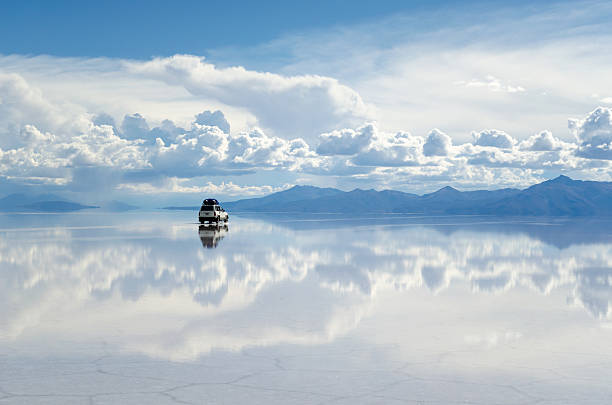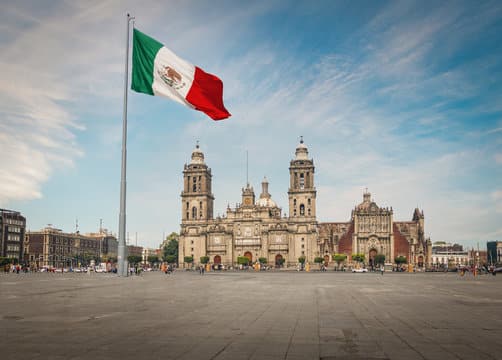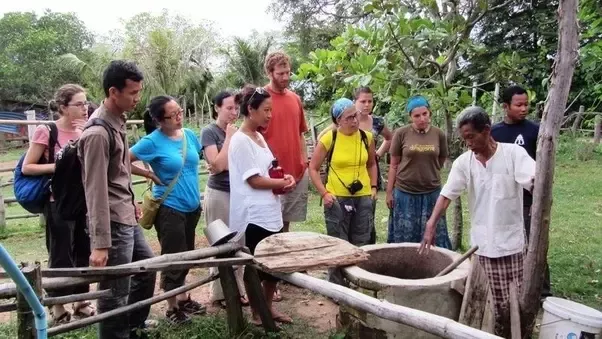Salar de Uyuni

Salar de Uyuni is a world’s largest natural salt flat located southwest of Bolivia, South America. It Covers an area of over 10,000 square kilometres stretching till Altiplano, considered as the one of the most extreme and effective vistas in all over South America.
Renowned for its stunning and more mesmerising salt flat nowhere available to see in the world. Its vast expanse of white salt crust creates a mirror effect during rain periods which is considered one of the most mesmerising and photographic things in the world.
Related Search: Hot Springs in Saturnia, Italy.
How was Salar de Uyuni Formed?

World’s largest lake was formed dated back to ancient times due to the geological processes. Approximately around 40,000 years ago, this salt flat was covered by the waters of Lake Minchin. Some point of time due to the movement of plate tectonics beneath made the water retract to the lower areas. From the effects of temperature and climate changes over a period of time the lake dried up, leaving behind several salt flats including Salar de Uyuni. Interestingly these areas are known for rich lithium reserves, more popularly used for the battery productions.
Thousands of years later, the evaporation of water from this lake deposited layers of salt and minerals, which created a vast and massive salt flat and crust. Under the surface of saltwater, groundwater is always feeding on rainwater, which is 10 times more than the scale of the precipitation. In a simple way we can conclude Salae de Uyuni as a “Giant dried up Desert Lake”.
Today Salar de Uyuni is the perfect spot in South America to visit, due to its stunning and unique natural landmarks. From its multiple natural beauties and vast salt area, the lake receives around 300,000 visitors annually.
10 Amazing Facts about Salar de Uyuni Salt Flat, Bolivia
Despite its vast collections of salt areas and unique geological formations, the place is renowned for some of the most unique and amazing facts.
- It is home to Interesting Faunas. Lot of people believed that, salt flat is a barren land and nothing can live there. But habitants like flamingos, hares, and native foxes are major faunas living here.
- Often known as “Mirror World”. Salar de Uyuni contains special features such as mirror-like properties that are more visible to us during the rainy season. Its flatness creates a reflection of the landscapes which are known as the most beautiful things on our planet to watch during sunset time.
- Salar de Uyuni has a salt hotel, “Luna Salada” which is exclusively made by the salt. Sounds interesting right, yes, the hotel includes a bed, floors, walls and furniture are completely made through salt. Hotel offers pretty feelings and memories to visitors, especially those who stayed overnight.
- A Lithium Mining Centre. According to some estimates Salar de Uyuni holds 21 million tons of Lithium, making it half of the world’s lithium reserves. Lithium plays a very vital role in the production of batteries, electric vehicles and other lithium parts.
- World’s largest Salt Flat. Covering an area of 10,000 square kilometres, Uyuni Salt Flats Bolivia is much bigger than Bonneville Salt Flats in Utah, USA (300 square kilometres).
- Ancient Trade Route. Moreover, just a tourist destination in recent centuries, the lake is an essential trade route for indigenous communities. People transported goods and stuff between the Andes and Pacific coast through Salt flats.
- Home to the 2 famous islands. Isla Incahusai and Isla el Pescado are the 2 major islands within the park. Both islands are well known for iconic sunrise views and houses giant cacti.
- Sacred Place. Yes along with natural beauties and ancient significances. Uyuni Salt Flats has cultural and spiritual values from the indigenous communities of this region. The Aymara and Quechua are the people who still believe that place is to heal and purify property to them.
- Place is full of Hexagons. Salar de Uyuni arrange Hexagonal formations. Which includes patterns of salt grounds, efficient shape, located in the unreachable places.
- Most Photographic destination in the World. Due to its flat, reflective surfaces create optical illusions that blur the lines between the sky and ground, creating more unique shots. Photographers can take perfect angles or shots that play with scale, perspective and interplay of light and shadow in a photograph.
Read About: White Sands National Park.
When to Go?

Salar de Uyuni has 2 different seasons for visitors to explore its beauty. First is the Rain Season, which usually starts from December to April, when visitors most likely come to enjoy the breath-taking views and mirror effects. During these periods, layers of the water cover salt flats, which reflects sky and clouds that stretch so far.
Dry Season starts from May to November, when visitors feel cooler, hard lake grounds and importantly travellers can drive across the stark white landscapes. During the dry flats season salt lake helps us to catch clear views of the intricate hexagonal patterns of this salt.
How to Get There
Getting to Salar de Uyuni is really a puzzle game, because it is located in a remote location, under the Bolivia and Chile border and the Bolivia and Argentina border. So, it depends on where you are coming from and mode of transportation used.
1. From Bolivia
Visitors who come from Bolivia, you should probably travel from La Paz, one of the most possible place to find transportation to Uyuni. Visitors can either choose Bolivia Hop bus services or flights from different airlines (takes 1 hour to reach) to reach La Paz to Uyuni.
2. From Chile
Time consuming journey from San Pedro de Atacama to Uyuni requires 3 to 4 days of travel. More cost effective mode of travel, ideal for those who wish to return to Chile. Since it is a long day tour obviously visitors can expect less crowds in buses, and they can freely take photos and explore nearby destinations.
3. From Peru
Travellers coming from Peru will have to make their way from Lima, Puno or Cusco to Uyuni. From Lima to La Paz there are many flights available and from there you need to take buses. Usually from Lima to La Paz includes 2 hours of journey with a cost of $300. But the sad part is, visitors will miss to see some of the iconic landmarks like Machu Picchu and Inca Capital of Cusco. So it is very important to travel by bus.
From Cusco to Uyuni there are a good number of bus companies that run from Cusco. Peru Hop and Bolivia Hop are the major bus services shifts all passengers get through border of the Bolivia.
Related Articles: Blue Lagoon, Iceland.




